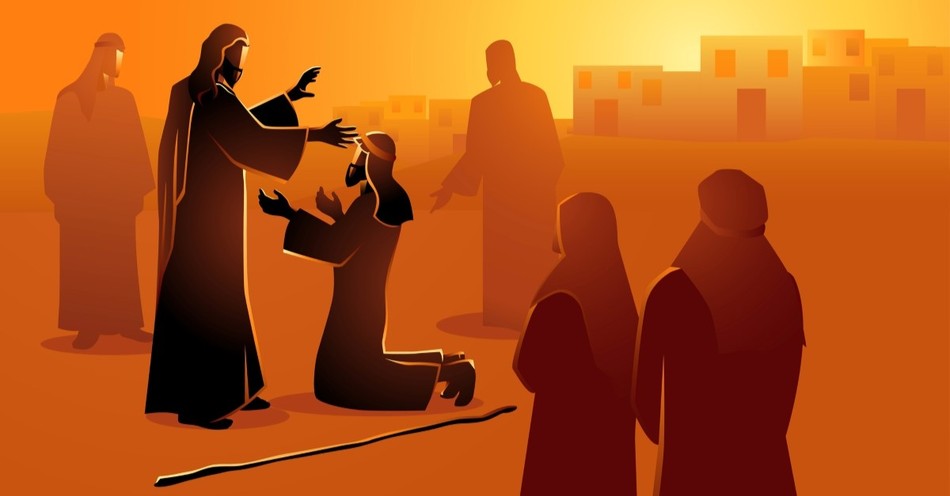Jesus came to seek and to save the lost. Accusing Jesus of being demon-possessed and labeling him a despised Samaritan, the religious elite sought to kill Jesus. They picked up stones to stone Him, but He slipped away from the temple grounds.
And, as Jesus “went along, he saw a man blind from birth” (John 9:1), a beggar with a cup in hand asking for alms. The disciples asked, “Rabbi, who sinned, this man or his parents that he was born blind?” Without hesitation, Jesus replied that neither he nor his parents had sinned, “but this happened so that the works of God might be displayed in his life”(9:3).
Why did Jesus want “the works of God displayed in his life?” Moved by love and compassion towards the blind man who suffered from birth, Jesus sought the blind man, He gave sight to the blind man, and He saved the blind man.
“As long as it is day, we must do the works of him who sent me. Night is coming, when no one can work. While I am in the world, I am the light of the world” (9:4-5).
Giving sight to the blind and bringing people “out of darkness” was urgent. Jesus, the Light of the world, fulfilled the Messianic prophecies of bringing freedom for prisoners of darkness and recovery of sight for the blind (Isaiah 61:1-3; Luke 4:18). Jesus did the miraculous.
Jesus Sought the Blind Man
As Jesus “went along, he saw a man blind from birth” (John 9:1). The text doesn’t tell us why Jesus immediately noticed the blind man. Maybe because he begged along the road, and Jesus felt compassion.
As a deity, Jesus knew. He saw the need for the blind man to “see, being made whole spiritually and physically. Jesus was moved with compassion for this lost sheep of Israel when he “saw” him and went to him to give not only the gift of healing of sight but of spiritual sight.
Jesus sought the blind man.
Jesus Gave Sight to the Blind Man
Jesus could have spoken a word to heal, but this time used dirt and saliva to cover the blind eyes. Feeling the dirt on his eyes, did he have thoughts of anticipation or doubts racing through his mind? “Why did he put mud on my eyes?” “Can I really see, after all these years?” “Who is this man?” “Can he make me see?”
He could have begun to doubt and removed the mud from his eyes. But he didn’t. Jesus told him to wash off the dirt in the pool. Why didn’t Jesus heal him right where he stood?
Why make him go to the pool? Could he find his way? He would have to get into the water. Did he need help? Did he know how to swim if he fell into the water?
After being blind for his entire lifetime, perhaps a trip to the pool was not a big deal. “So he went and washed, and came home seeing.”
Another healing of a lost man who thought he could see but became blind. In the darkness of sin, a Pharisee, Saul of Tarsus, was on the road to Damascus to persecute and murder Christians (Acts 9:13-18).
Crucial to healing the blind was coming to faith, being born again. Other passages of healing the blind reveal how faith was necessary for those asking to see (Luke 18:35-43; Mark 8:22-26, 10:46-52; Matthew 9:26-29).
In most cases, the blind received sight and followed Jesus. Blind Bartimaeus cried out, “Rabbi, I want to see.” “Go,” said Jesus, “your faith has healed you.” Immediately he received his sight and followed Jesus along the road (Mark 10:51, 52).
Luke 18:42-43 gives this account. “Receive your sight, your faith has healed you,” and, “Immediately, he received his sight and followed Jesus, praising God.”
In Matthew 9:27-29, two blind men called out, “Have mercy on us, Son of David!” Jesus touched their eyes and said, “according to your faith let it be done to you.” They could see.
Faith was essential to healing faith. Only God, who heals bodies and forgives sins, can do the impossible.
Jesus Saved the Blind Man
The Pharisees didn’t believe the blind man was healed. But the blind man, now healed, said, “Nobody has ever heard of opening the eyes of a man born blind.
If this man were not from God, he could do nothing.” The Pharisees accused him of being steeped in sin at birth and told him to stop lecturing them. They threw him out of the synagogue.
John 9:35-38 gives this account. Jesus heard the Pharisees threw him out and, when he found him, said, “Do you believe in the Son of Man?
“Who is he, sir?” the man asked. “Tell me so that I may believe in him.”
Jesus said, “You have now seen him; in fact, he is the one speaking with you.”
Then the man said, “Lord, I believe,” and he worshiped him.
Each account of healing the blind was a matter of faith in the Healer. The result? They followed Jesus and worshipped Him.
Further, in John 9:39-41, Jesus speaks clearly regarding the blindness of sin. He said:
For judgment I have come into this world, so that the blind will see and those who see will become blind.
Some Pharisees who were with him heard him say this and asked, “What? Are we blind too?”
Jesus said, “If you were blind, you would not be guilty of sin; but now that you claim you can see, your guilt remains.”
Jesus gives an important truth: the physical healing of the blind symbolized the need for spiritual healing from sin’s darkness.
The blind man’s physical healing led to seeing the truth of Jesus, giving spiritual sight, and removing sin. The light of Christ transforms a sinner into a saint, being forgiven, cleansed, healed, and made whole.
In each instance of the healings Jesus performed on the blind, faith arose for physical healing and faith to believe in Jesus.
Why Does This Matter?
Jesus heals today, as in John 9. His purpose is still to save those who are lost. And for those who are His children, the compassion and love of Jesus give miraculous, physical healing. When healing doesn’t come in an expected way, trust that God is working out what is best (Romans 8:28).
We are to “ask, and you will receive” (Matthew 7:7). A few examples are the healing of my husband’s broken hand in high school, my mom’s vision of heaven that healed her headaches, and our friend and missionary on his deathbed, who was healed of meningitis, and more.
It is God’s nature to heal. What is the significance of Jesus healing the blind man? It was the love of God for His people, who “wants all people to be saved and to come to a knowledge of the truth” (1 Timothy 2:4). Jesus continues to seek the blind, give sight to the blind, and save the blind, both physically and spiritually.
For further reading:
What Does the Bible Say about Healing?
What Miracles Did Jesus Perform?
Why Did Jesus Want His Miracles to Stay Secret?
Photo Credit: ©iStock/Getty Images Plus/rudall30


.jpg)


.jpg)